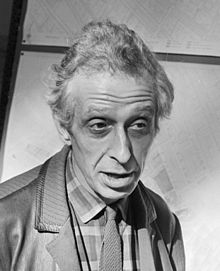Aldo van Eyck
Aldo van Eyck (born March 16, 1918 in Driebergen , † January 14, 1999 in Loenen aan de Vecht ) was a Dutch architect and is considered a founding father of structuralism in architecture.
Life
Aldo van Eyck was born in Driebergen as the second son of the Dutch critic and philosopher Pieter Nicolaas van Eyck . His older brother Robert Floris van Eyck became an artist and art restorer .
Van Eyck studied architecture, initially at the Royal Academy of Fine Arts in The Hague , and from 1938 to 1942 at the Swiss Federal Institute of Technology in Zurich , where he came into contact with the international avant-garde.
Then van Eyck first worked as an employee at the urban development office of the Amsterdamer Stadtwerke, until he founded his architectural office in 1951 and worked as a freelancer. Between 1947 and 1978, around 730 playgrounds were built according to his designs in Amsterdam, including in the Jeruzalem settlement .
In 1960 his first large building, the City Orphanage in Amsterdam, was completed. It is considered a key work of structuralism, renovated in 2014 and placed under monument protection. A number of other important buildings in the city followed.
Van Eyck was the editor of the architecture magazine Forum from 1959 to 1963 and had a great influence on Dutch architecture. As a co-founder of Team Ten , he played an important role in the CIAM ( Congrès Internationaux d'Architecture Moderne ). From 1966 to 1984 he was a professor at the TU Delft.
He was also active in Germany: in 1971 he created the Schmela Gallery , the first gallery building in the Federal Republic of Germany built for this purpose in the structuralism style . Today's user of the Kunstsammlung Nordrhein-Westfalen dedicated an exhibition to Aldo van Eyck there in 2013.
Van Eyck had worked with his wife Hannie since 1982, and they designed the office buildings for the European Space Agency in Noordwijk and the Tripoli building in Amsterdam.
In 1990 van Eyck was awarded the Royal Gold Medal by the Royal Institute of British Architects . In the same year he also received the Austrian Decoration for Science and Art .
buildings
- 1957 - 1960: City orphanage in Amsterdam location
- 1965 - 1966: Sculpture pavilion, Sonsbeek exhibition in Arnhem (demolished after the exhibition)
- 1968 - 1970: Catholic Church in The Hague location
- 1968, 1974: Renovation of Martin Visser's house in Bergeijk location
- 1971: Residential and gallery house of the Schmela Gallery in Düsseldorf location
- 1975 - 1979: Hubertusheim in Amsterdam location
- 1984 - 1989: Office building for ESTEC in Noordwijk Lage
- 1990 - 1994: Tripoli complex in Amsterdam, Amstelveenseweg location
- 1997: New building for the Court of Auditors in The Hague
gallery
Web links
- Literature by and about Aldo van Eyck in the catalog of the German National Library
- Aldo van Eyck at Architectuur.org
- Aldo van Eyck. In: arch INFORM . (Short biography and list of projects)
- Aldo van Eyck's playgrounds , Neue Zürcher Zeitung of July 17, 2002
Individual evidence
- ^ Db metamorphosis office landscape instead of orphanage
- ^ Kunstsammlung Nordrhein-Westfalen (ed.): Alfred Schmela on the 100th birthday, flyer for the exhibition . Düsseldorf 2018.
- ↑ Link to the Aldo van Eyck exhibition "The Child, the City and Art in the NRW Art Collection
- ↑ Heemschut Amsterdam vraagt monument status voor Tripolis van Van Eyck
| personal data | |
|---|---|
| SURNAME | Eyck, Aldo van |
| BRIEF DESCRIPTION | Dutch architect |
| DATE OF BIRTH | March 16, 1918 |
| PLACE OF BIRTH | Driebergen |
| DATE OF DEATH | January 14, 1999 |
| Place of death | Loenen aan de Vecht |







